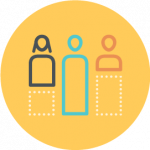What’s next in our exploration of distributed leadership
This past year, we released a series of case studies on how different organizations are distributing leadership—that is, how they bring more of their staff into decision-making processes. Along with our partners at the Hewlett Foundation and Open Mind Consulting, we learned a ton about how these organizations share information, authority, and responsibility to make distributed leadership work. But learning about these practices, turns out, raised more questions than answered them. In several of the cases, organizations tapped distributed leadership practices in the process of creating conditions for more equitable and inclusive workplaces. Others were beginning to realize, despite their decades of highly democratized decision-making, that they needed to extend their efforts to reach new audiences and connect with their local community.

This made us wonder: Is there a relationship between organizations’ efforts to be more diverse, equitable, and inclusive, and the practices and cultural orientation required of distributed leadership? Can the mechanisms for distributing leadership pave the way for more inclusive organizations? Or do organizations need to have a foundation of inclusion and disrupting historical power structures in order to effectively distribute leadership? And a current running through all of our questions is the role philanthropy plays in shaping and influencing the contours of equity and inclusion within the nonprofit sector.
Questions like these have us opening up all kinds of doors. By looking at distributed leadership practices a little more closely, we might get a fresh angle on how organizations grapple with questions of who holds, gives up, and gains power. Ultimately, we seek to shed more light on how tackling these questions can render meaningful change in our nonprofit workplaces, where everyone can belong and contribute.

